NCERT Class 10 Maths Chapter 7: Coordinate GeometryExercise 7.11. Find the distance between the following pairs of points :
Solution I. Let (2, 3) = (x1, y1) and (4, 1) = (x2, y2). Distance between the given points: 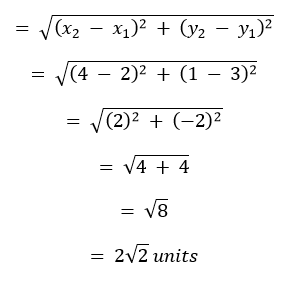
Hence, the distance between the given pair of point is 2√2 units. II. Let (-5, 7) = (x1, y1) and (-1, 3) = (x2, y2). Distance between the given points: 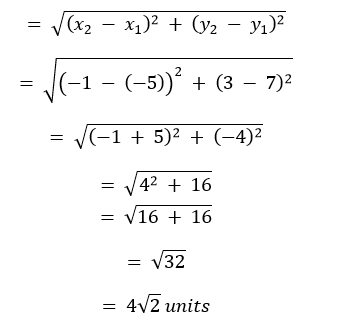
Hence, the distance between the given pair of point is 4√2 units. III. Let (a, b) = (x1, y1) and (-a, -b) = (x2, y2). Distance between the given points: 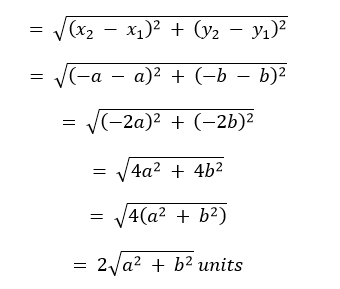
Hence, the distance between the given pair of point is 2√(a2 + b2) units. 2. Find the distance between the points (0, 0) and (36, 15). Can you now find the distance between the two towns A and B discussed in Section 7.2. Solution Let (0, 0) = (x1, y1) and (36, 15) = (x2, y2). Distance between the given points: 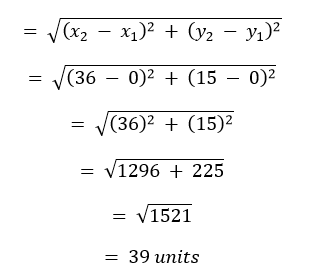
(The two towns A and B in section 7.2 share the same coordinates as given in first part of question, hence, distance between them will be 39 km.) 3. Determine if the points (1, 5), (2, 3) and (- 2, - 11) are collinear. Solution Let the given coordinates (1, 5), (2, 3) and (- 2, - 11) be A, B and C respectively. If the points are collinear then the sum of the shorter distances will be the same as the longest distance. Distance between A and B: 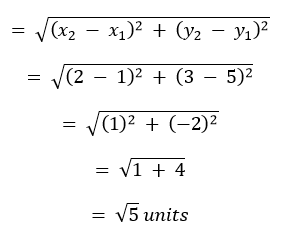
Distance between B and C: 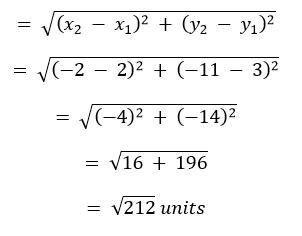
Distance between A and C: 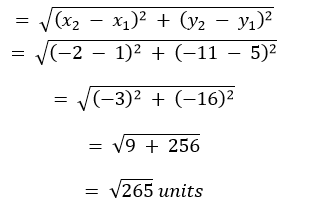
Sum of shorter distance = √5 + √212 = √217 units Since √217 ? √265, therefore, the given points are not collinear. 4. Check whether (5, - 2), (6, 4) and (7, - 2) are the vertices of an isosceles triangle. Solution Let the given coordinates (5, -2), (6, 4) and (7, -2) be A, B and C respectively. If the points form an isosceles triangle then two of the distances between the a pair of points must be equal. 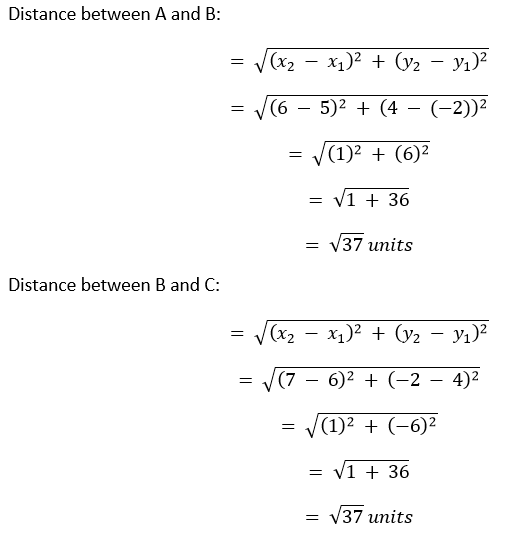
Since, AB = BC. Therefore, the given points will form an isosceles triangle. 5. In a classroom, 4 friends are seated at the points A, B, C and D as shown in Fig. 7.8. Champa and Chameli walk into the class and after observing for a few minutes Champa asks Chameli, "Don't you think ABCD is a square?" Chameli disagrees. Using distance formula, find which of them is correct. 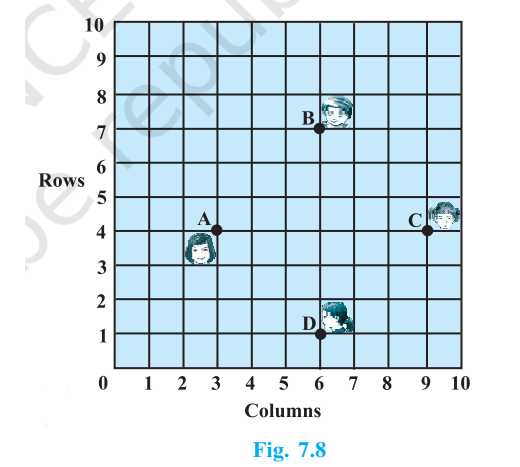
Solution If ABCD forms a square then all sides must be equal, i.e, AB = BC = CD = AD and the diagonals AC and BD must be equal as well. 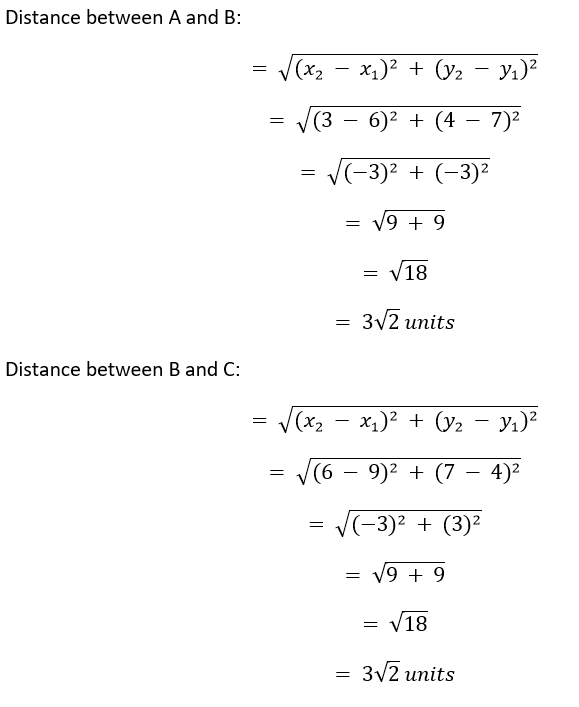
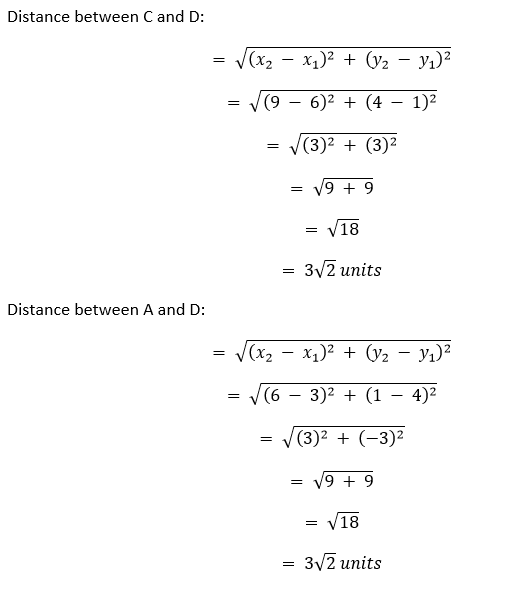
Since, AB = BC = CD = AD. Therefore, ABCD forms a quadrilateral with all sides equal, i.e, a rhombus or a square. We will find length of diagonals to find out whether ABCD is a rhombus or a square. 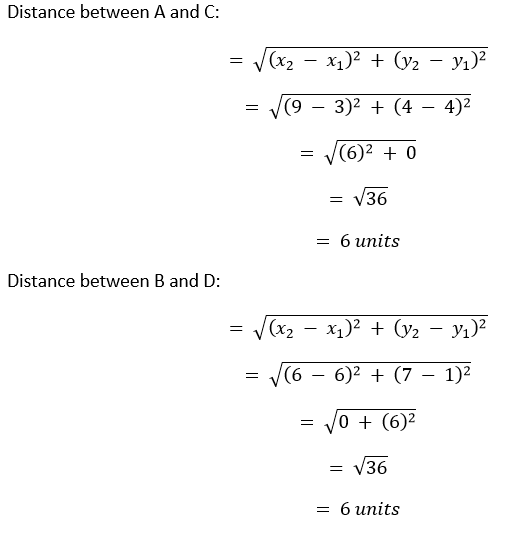
Since, the diagonals of ABCD are equal. Therefore, the quadrilateral is a square. Hence, Champa is correct. 6. Name the type of quadrilateral formed, if any, by the following points, and give reasons for your answer:
Solution I. Let the given coordinates (-1, -2), (1, 0), (-1, 2) and (-3, 0) be A, B, C and D respectively. 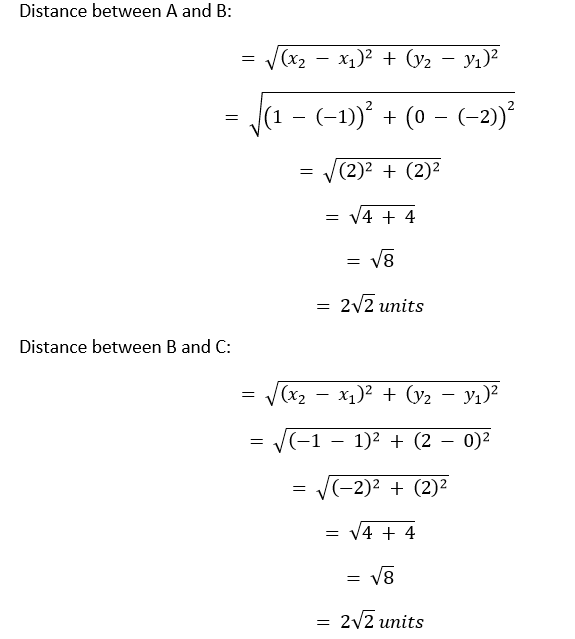
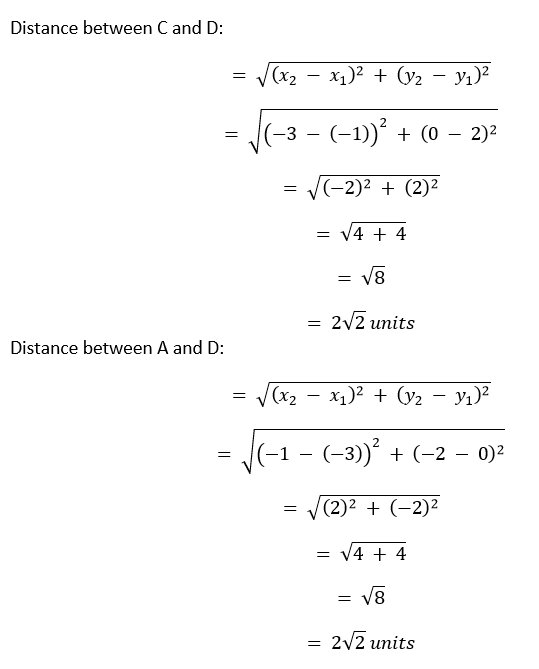
Since, AB = BC = CD = AD. Therefore, ABCD forms a quadrilateral with all sides equal, i.e, a rhombus or a square. We will find length of diagonals to find out whether ABCD is a rhombus or a square. 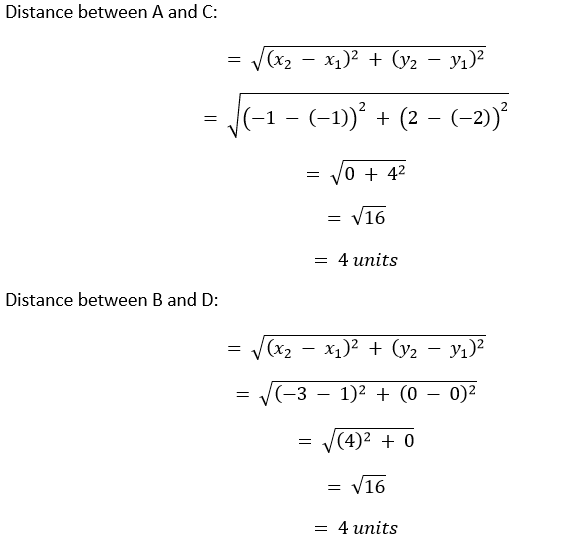
Hence, the given points make up a square. II. Let the given coordinates (-3, 5), (3, 1), (0, 3) and (-1, -4) be A, B, C and D respectively. 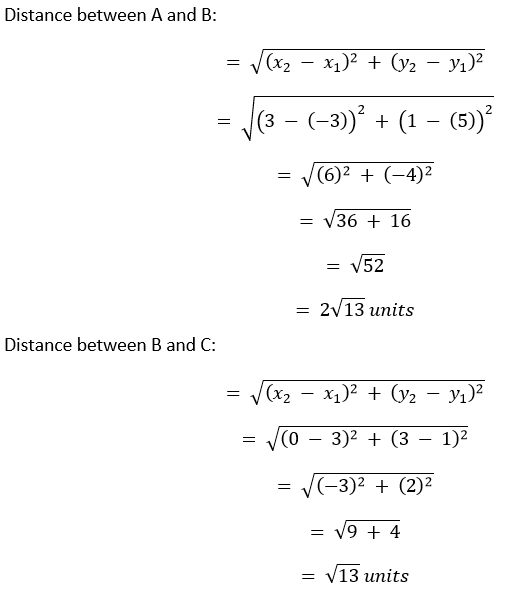
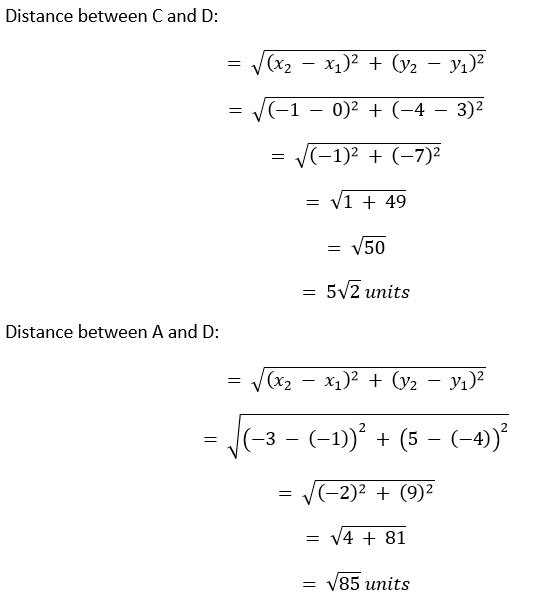
No quadrilateral is formed by the given points. III. Let the given coordinates (4, 5), (7, 6), (4, 3) and (1, 2) be A, B, C and D respectively. 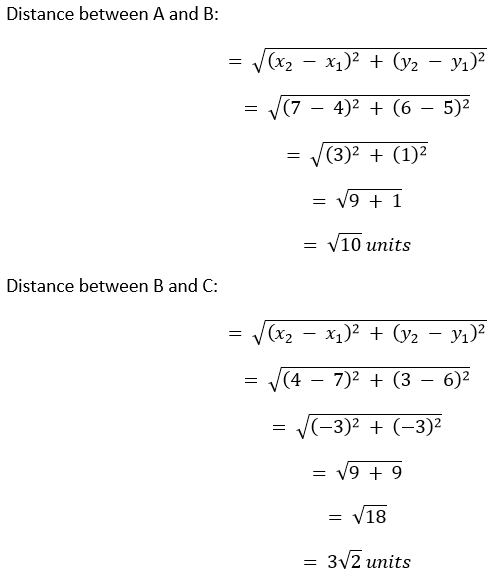
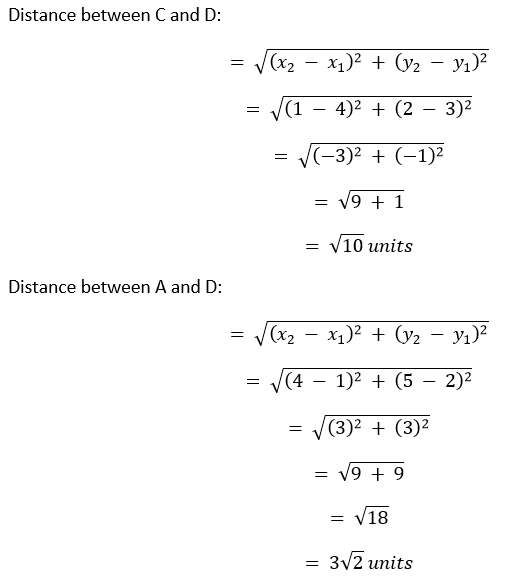
Since, AB = CD and BC = AD. Therefore, ABCD forms a quadrilateral with opposite sides equal, i.e., a parallelogram or a rectangle. We will find length of diagonals to find out whether ABCD is a parallelogram or a rectangle. 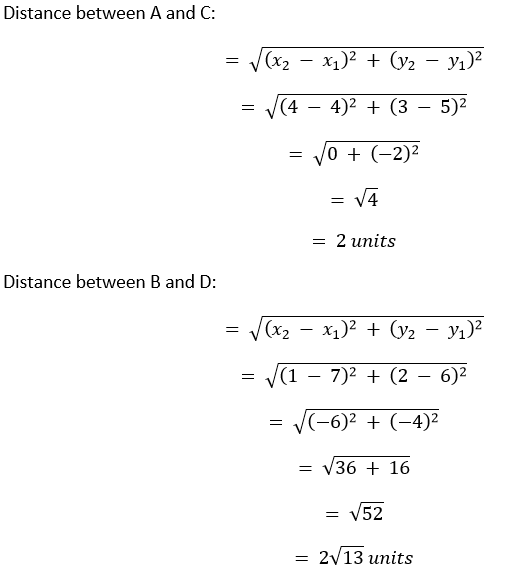
The diagonals are unequal. Hence, the given points make up a parallelogram. 7. Find the point on the x-axis which is equidistant from (2, -5) and (-2, 9). Solution The required point lies on the x-axis, which implies that its y-coordinate is 0. Then, let the required point be (x, 0). According to question: Distance between (2, -5) and (x, 0) = Distance between (x, 0) and (-2, 9) 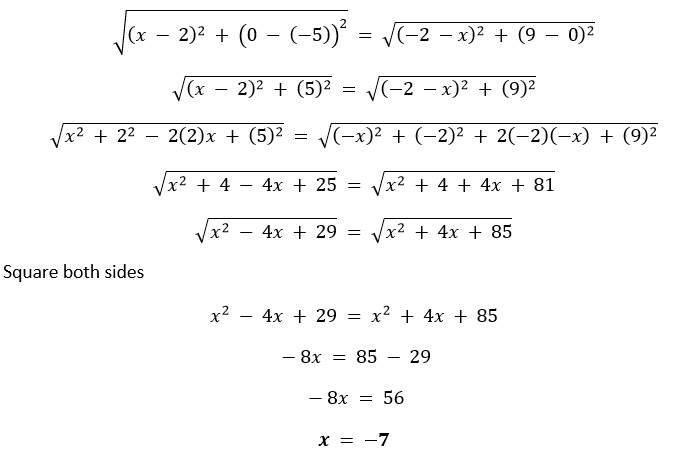
Hence, the required point will be (-7, 0). 8. Find the values of y for which the distance between the points P(2, - 3) and Q(10, y) is 10 units. Solution It is given that: Distance between P and Q = 10 units 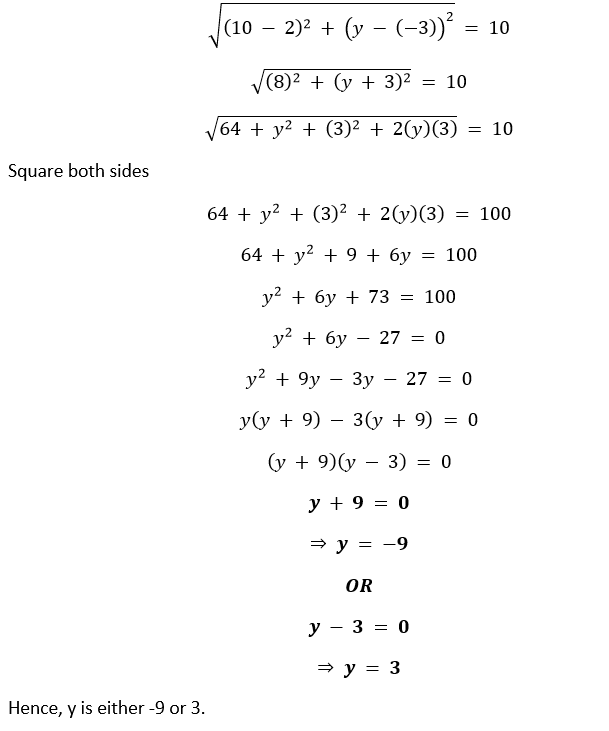
9. If Q(0, 1) is equidistant from P(5, -3) and R(x, 6), find the values of x. Also find the distances QR and PR. Solution According to question, we have: Distance between Q and P = Distance between Q and R 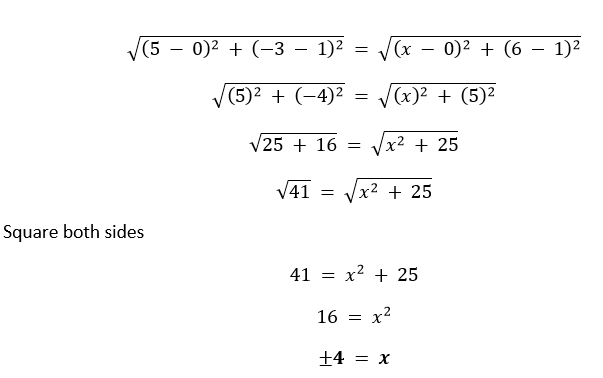
Therefore, x is either 4 or -4. Case I: When x = 4. 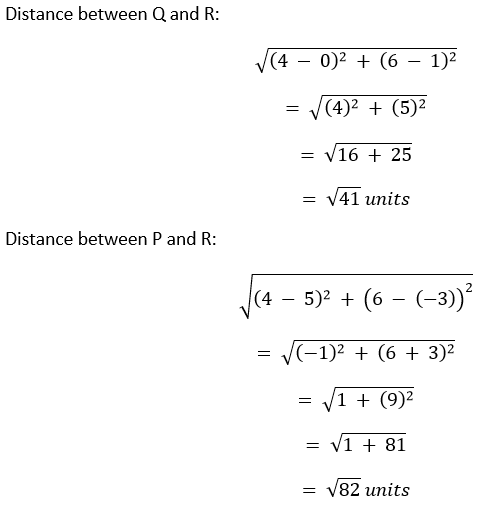
Case II: When x = -4. 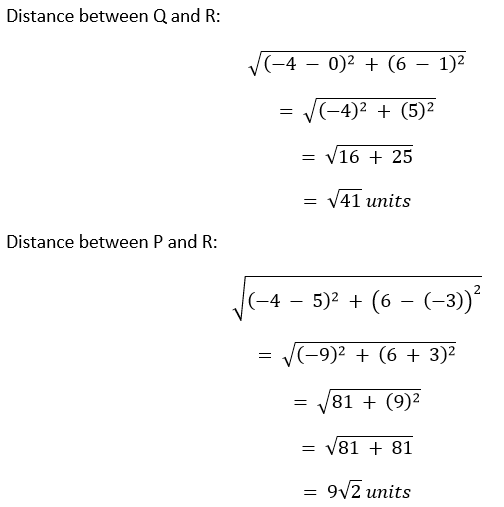
Hence, x = �4 and distances QR and PR are √41 units and √82 units respectively OR √41 units and 9√2 units respectively. 10. Find a relation between x and y such that the point (x, y) is equidistant from the point (3, 6) and (- 3, 4). Solution According to the question, we have: Distance between (3, 6) and (x, y) = Distance between (-3, 4) and (x, y) 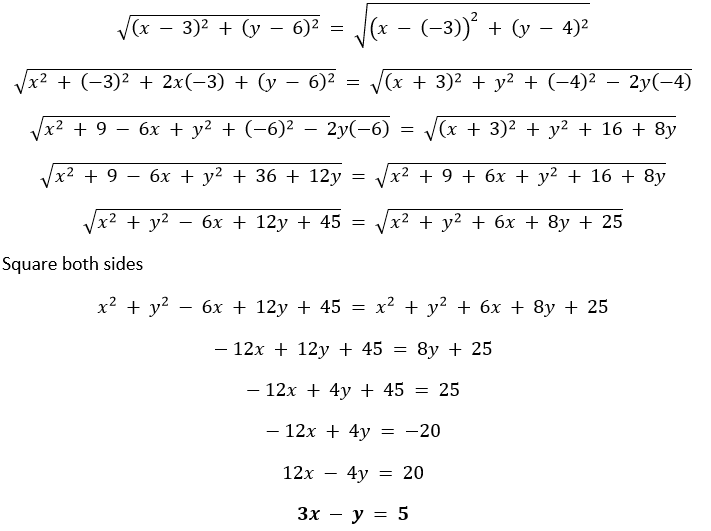
Hence, 3x - y = 5 is the required relation. Exercise 7.21. Find the coordinates of the point which divides the join of (-1, 7) and (4, -3) in the ratio 2 : 3. Solution Let the given points be A (-1, 7) and C (4, -3), whose join is divided in the ratio by point B (x, y). The coordinates of B will be: 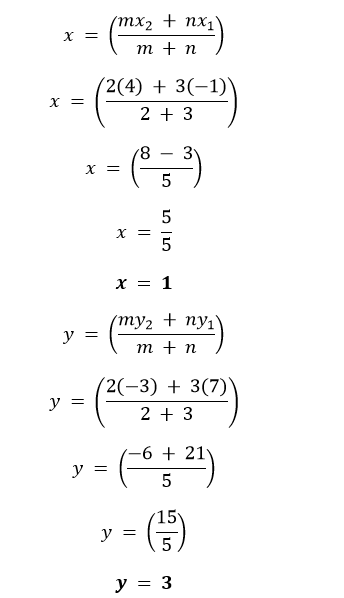
Hence, the required point is (1, 3). 2. Find the coordinates of the points of trisection of the line segment joining (4, -1) and (-2, -3). Solution Let the points be A (4, -1) and D (-2, -3) which are being trisected by two point B (x, y) and C (X, Y). Since the line AD is being trisected, therefore, AD is divided by B in 1 : 2 ratio and by C in 2 : 1 ratio. Therefore, 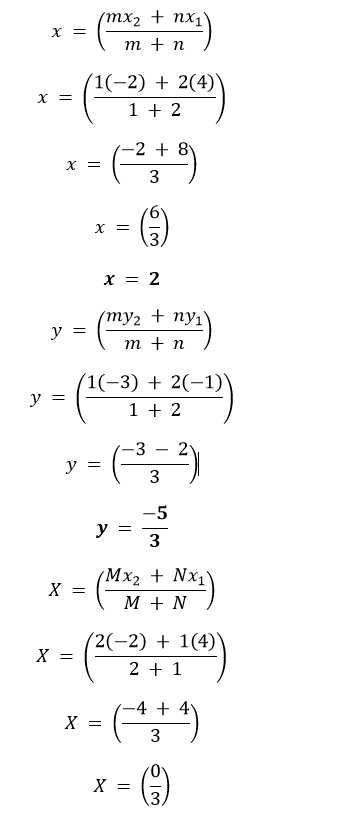
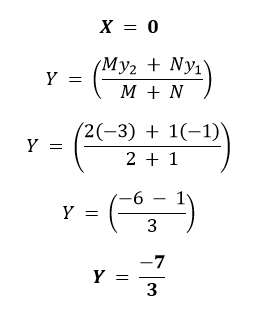
Hence, the required point are (2, -5/3) and (0, -7/3). 3. To conduct Sports Day activities, in your rectangular shaped school ground ABCD, lines have been drawn with chalk powder at a distance of 1m each. 100 flower pots have been placed at a distance of 1m from each other along AD, as shown in Fig. 7.12. Niharika runs 1/4 th the distance AD on the 2nd line and posts a green flag. Preet runs 1/5 th the distance AD on the eighth line and posts a red flag. What is the distance between both the flags? If Rashmi has to post a blue flag exactly halfway between the line segment joining the two flags, where should she post her flag? 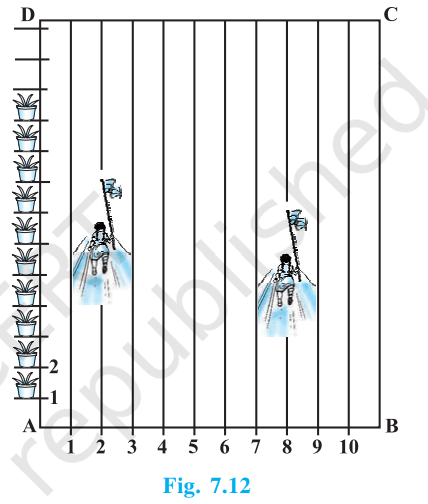
Solution Total distance of AD = 100 m Niharika ran in the 2nd line and posted the flag at 1/4 of the distance of AD. Therefore, position of green flag = (2, 1/4 × 100) = (2, 25) Preet ran in the 8th line and posted the flag at 1/5 of the distance of AD. Therefore, position of red flag = (8, 1/5 × 100) = (8, 20) Distance between the two flags : 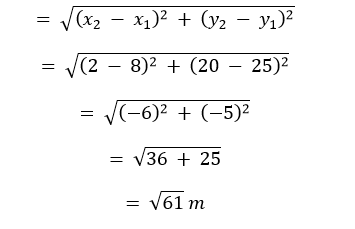
Hence, distance between the red flag and the green flag is √61 m. The blue flag needs to be posted at the midpoint of the line formed by joining the red and the green flags. Then, the blue flag's coordinates are: 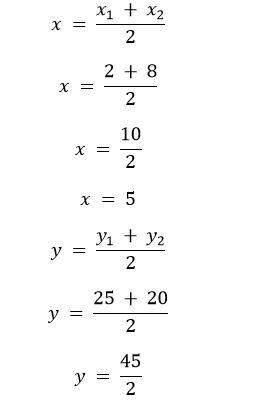
Hence, Rashmi needs to post the blue flag at 45/2 m in the 5th line. 4. Find the ratio in which the line segment joining the points (- 3, 10) and (6, - 8) is divided by (- 1, 6). Solution Let the given points be A (-3, 10) and C (6, -8) being divided by the point B (-1, 6). According to the section formula: 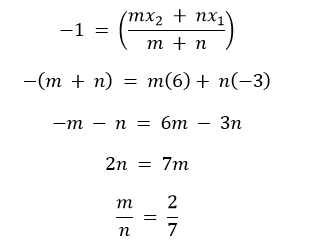
Hence, the required ratio is m : n = 2 : 7. 5. Find the ratio in which the line segment joining A(1, - 5) and B(- 4, 5) is divided by the x-axis. Also find the coordinates of the point of division. Solution Since, the given line segment is being divided by the x-axis, therefore the coordinates of the dividing point will be (x, 0). According to the section formula, we can say that: 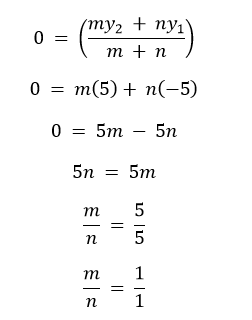
Hence, the line segment AB is being divided in 1 : 1 ratio. This implies that the dividing point on x-axis is the mid-point of AB. Therefore, 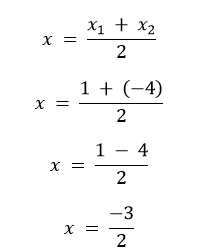
Hence, the required point is (-3/2, 0). 6. If (1, 2), (4, y), (x, 6) and (3, 5) are the vertices of a parallelogram taken in order, find x and y. Solution Let the given points be A (1, 2), B (4, y), C (x, 6) and D (3, 5). Since, ABCD forms a parallelogram, the diagonals AC and BD will bisect each other at (X, Y). Therefore, 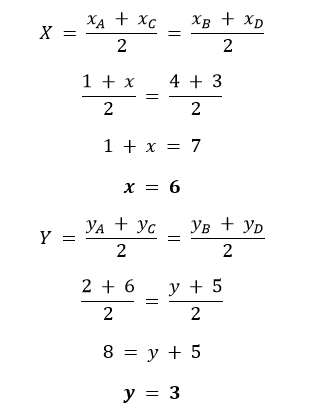
Hence, x = 6 and y = 3. 7. Find the coordinates of a point A, where AB is the diameter of a circle whose centre is (2, - 3) and B is (1, 4). Solution Let A be (x1, y1). The centre of the circle is the mid-point of diameter. Therefore, (2, -3) is mid-point of AB. This implies that: 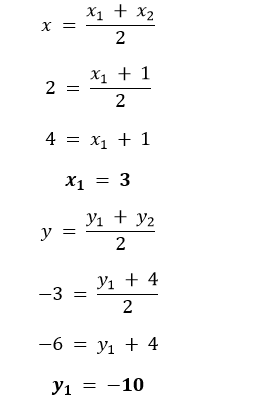
Hence, the point A will be (3, -10). 8. If A and B are (- 2, - 2) and (2, - 4), respectively, find the coordinates of P such that AP = 3/7 AB and P lies on the line segment AB. Solution 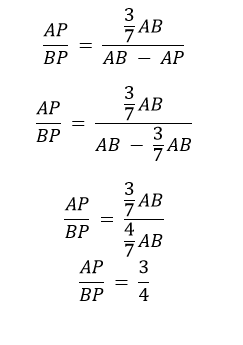
Therefore, point P divides AB in 3 : 4 ratio. Then, coordinates of P will be: 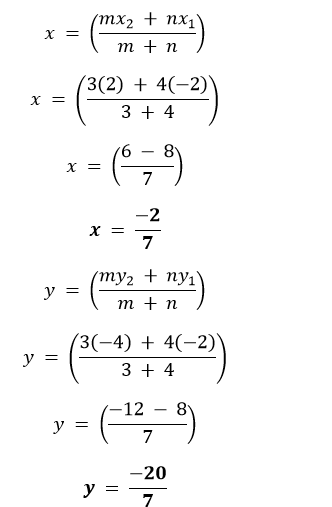
Hence, the coordinates of P are (-2/7, -20/7). 9. Find the coordinates of the points which divide the line segment joining A(- 2, 2) and B(2, 8) into four equal parts. Solution Let P (a, b), Q (x, y) and R (α, β) be the three required points. It is given that P, Q and R divide the line segment AB into four equal parts. This implies that Q will be the mid-point of AB, P will be the mid-point of AQ while R will be the mid-point of BQ. Coordinates of Q : 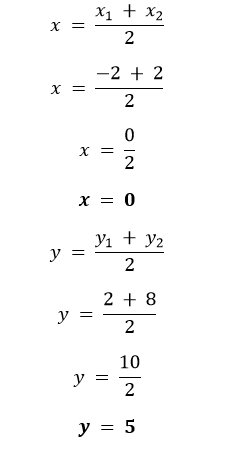
Therefore, Q is (0, 5). Coordinates of P : 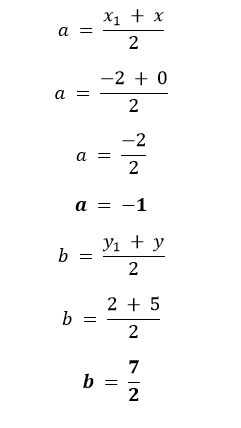
Therefore, P is (-1, 7/2). Coordinates of R : 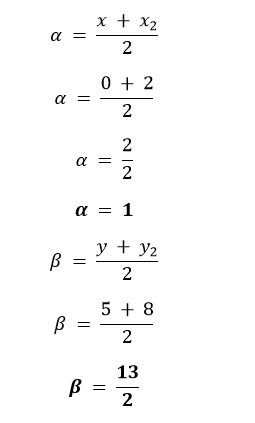
Therefore, R is (1, 13/2). Hence, the required points are (-1, 7/2), (0, 5), and (1, 13/2). 10. Find the area of a rhombus if its vertices are (3, 0), (4, 5), (- 1, 4) and (- 2, - 1) taken in order. [Hint : Area of a rhombus = ½(product of its diagonals)] Solution Let the vertices of rhombus be A (3, 0), B (4, 5), C (-1, 4) and D (-2, -1). 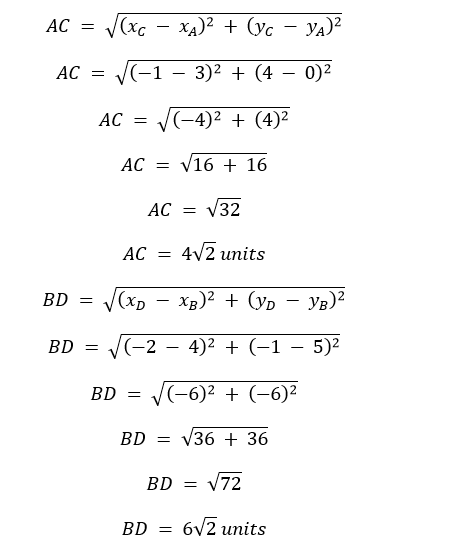
Area of the given rhombus = ½ × AC × BD = ½ × 4√2 × 6√2 = ½ × 48 = 24 square units. Hence, the area of given rhombus is 24 sq. units. Exercise 7.31. Find the area of the triangle whose vertices are :
Solution I. Area of the given triangle = ½[x1(y2 - y3) + x2(y3 - y1) + x3(y1 - y2)] = ½[2(0 - (-4)) - 1(-4 - 3) + 2(3 - 0)] = ½[2(4) - 1(-7) + 2(3)] = ½[8 + 7 + 6] = ½[21] = 21/2 = 10.5 square units II. Area of the given triangle = ½[x1(y2 - y3) + x2(y3 - y1) + x3(y1 - y2)] = ½[-5(-5 - 2) + 3(2 - (-1)) + 5(-1 - (-5))] = ½[-5(-7) + 3(3) + 5(4)] = ½[35 + 9 + 20] = ½[64] = 64/2 = 32 square units
Solution I. If the points are collinear then the area of triangle formed by them will be 0. Area of triangle formed by the points = ½[x1(y2 - y3) + x2(y3 - y1) + x3(y1 - y2)] 0 = ½[x1(y2 - y3) + x2(y3 - y1) + x3(y1 - y2)] 0 = [7(1 - k) + 5(k - (-2)) + 3(-2 - 1)] 0 = [7 - 7k + 5(k + 2) + 3(-3)] 0 = [7 - 7k + 5k + 10 - 9] 0 = [- 2k + 8] -8 = -2k k = 4 II. If the points are collinear then the area of triangle formed by them will be 0. Area of triangle formed by the points = ½[x1(y2 - y3) + x2(y3 - y1) + x3(y1 - y2)] 0 = ½[x1(y2 - y3) + x2(y3 - y1) + x3(y1 - y2)] 0 = [8(-4 - (-5)) + k(-5 - 1) + 2(1 - (-4))] 0 = [8(-4 + 5) + k(-6) + 2(5)] 0 = [8(1) - 6k + 10] 0 = [8 - 6k + 10] 0 = - 6k + 18 -18 = -6k k = 3 3. Find the area of the triangle formed by joining the mid-points of the sides of the triangle whose vertices are (0, -1), (2, 1) and (0, 3). Find the ratio of this area to the area of the given triangle. Solution Let the given points be A (0, -1), B (2, 1) and C (0, 3) with D, E and F being mid-points of AB, BC, and AC respectively. Coordinates of D : 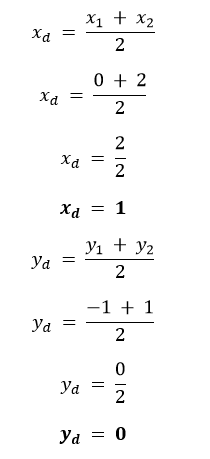
D is (1, 0). Coordinates of E : 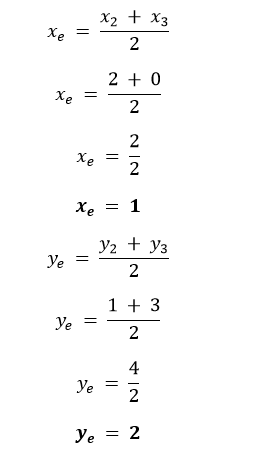
E is (1, 2). Coordinates of F : 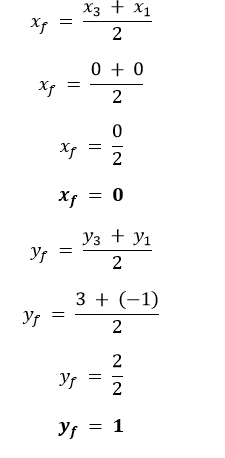
F is (0, 1). Area of DEF = ½[x1(y2 - y3) + x2(y3 - y1) + x3(y1 - y2)] = ½[1(2 - 1) + 1(1 - 0) + 0(0 - 2)] = ½[1(1) + 1(1) + 0] = ½[1 + 1 + 0] = ½[2] = 1 square unit Area of ABC = = ½[0(1 - 3) + 2(3 + 1) + 0(-1 - 1)] = ½[0 + 2(4) + 0] = ½[0 + 8 + 0] = ½[8] = 4 square units Ratio of the areas of DEF and ABC = Area of DEF/ Area of ABC = ¼ = 1 : 4 Hence, the area of the triangle formed by joining mid-points of given triangle is 1 square unit and the ratio of the areas of two triangles is 1 : 4. 4. Find the area of the quadrilateral whose vertices, taken in order, are (- 4, - 2), (- 3, - 5), (3, - 2) and (2, 3). Solution Let the given quadrilateral's vertices be A (-4, -2), B(-3, -5), C(3, -2), and D(2, 3). We can divide ABCD into two triangles ABC and ADC and find the sum of their areas in order to find the area of ABCD. Area of a triangle = ½[x1(y2 - y3) + x2(y3 - y1) + x3(y1 - y2)] Area of ABC = ½[-4(-5 - (-2)) - 3(-2 - (-2)) + 3(-2 - (-5))] = ½[-4(-5 + 2) - 3(-2 + 2) + 3(3)] = ½[-4(-3) - 3(0) + 9] = ½[12 + 9] = ½[21] = 21/2 = 10.5 square units Area of ADC = ½[-4(-2 - 3) + 3(3 - (-2)) + 2(-2 - (-2))] = ½[-4(-5) + 3(3 + 2) + 2(-2 + 2)] = ½[20 + 3(5) + 2(0)] = ½[20 + 15] = ½[35] = 35/2 = 17.5 square units Area of ABCD = 10.5 + 17.5 = 28 square units Hence, the area of given quadrilateral is 28 square units. 5. You have studied in Class IX, (Chapter 9, Example 3), that a median of a triangle divides it into two triangles of equal areas. Verify this result for ∆ ABC whose vertices are A(4, - 6), B(3, -2) and C(5, 2). Solution Let AD be the median of triangle ABC. D will be the mid-point of BC. Therefore, coordinates of D will be 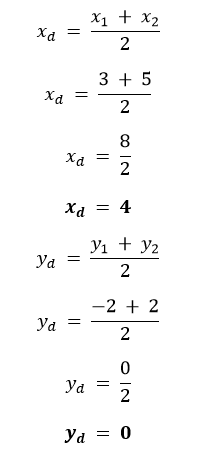
D is (4, 0). Area of a triangle = ½[x1(y2 - y3) + x2(y3 - y1) + x3(y1 - y2)] Area of triangle ADB = ½[4(0 - (-2)) + 4(-2 - (-6)) + 3(-6 - 0)] = ½[4(2) + 4(-2 + 6) + 3(-6)] = ½[8 + 4(4) - 18] = ½[8 + 16 - 18] = ½[6] = 6/2 = 3 square units Area of triangle ADC = ½[4(0 - 2) + 4(2 - (-6)) + 3(-6 - 0)] = ½[4(-2) + 4(2 + 6) + 3(-6)] = ½[-8 + 4(8) - 18] = ½[-8 + 32 - 18] = ½[6] = 6/2 = 3 square units Hence, proved that a median of a triangle divides it into two triangles of equal areas. Exercise 7.4 (Optional)1. Determine the ratio in which the line 2x + y - 4 = 0 divides the line segment joining the points A(2, - 2) and B(3, 7). Solution Let the ratio in which AB is divided by 2x + y - 4 = 0 be k : 1. Coordinates of the point of intersection can be obtained as : 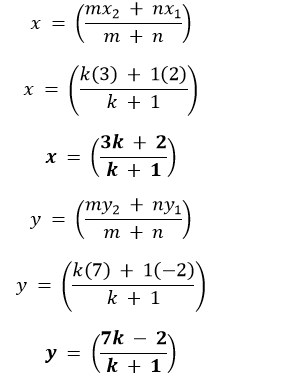
Since, the point of intersection will also lie on 2x + y - 4 = 0. Therefore, 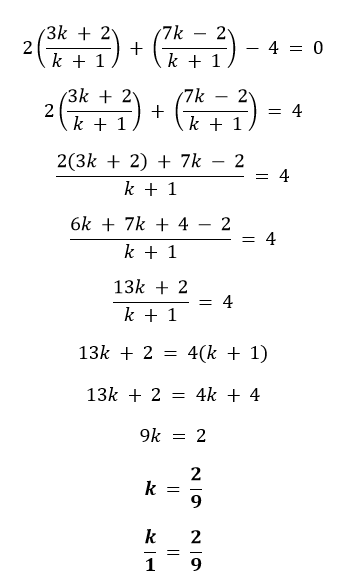
Hence, the ratio in which AB is divided by 2x + y - 4 = 0 is 2 : 9. 2. Find a relation between x and y if the points (x, y), (1, 2) and (7, 0) are collinear. Solution Since, it is given that the points are collinear. Therefore, the area of triangle formed by them will be 0. Area of triangle = ½[x1(y2 - y3) + x2(y3 - y1) + x3(y1 - y2)] 0 = ½[x(2 - 0) + 1(0 - y) + 7(y - 2)] 0 = ½[x(2) + 1(-y) + 7y - 14] 0 = ½[2x - y + 7y - 14] 0 = ½[2x + 6y - 14] 2x + 6y - 14 = 0 2(x + 3y - 7) = 0 x + 3y - 7 = 0 Hence, x + 3y - 7 = 0 is the required relation. 3. Find the centre of a circle passing through the points (6, - 6), (3, - 7) and (3, 3). Solution Let the centre of the circle be O (x, y) and the three points it passes through be A (6, -6), B (3, -7), and C (3, 3). 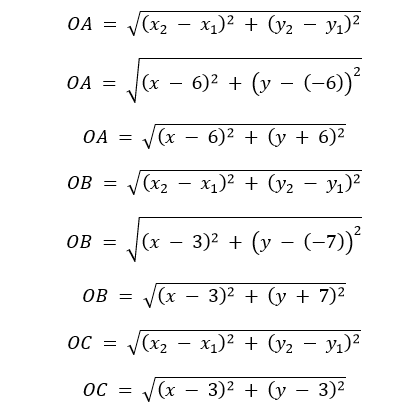
Since, OA, OB and OC are all radii of the same circle. Therefore, OA = OB = OC 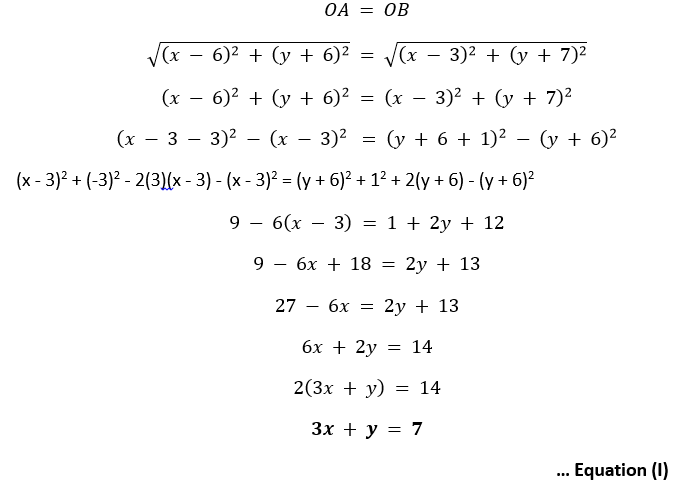
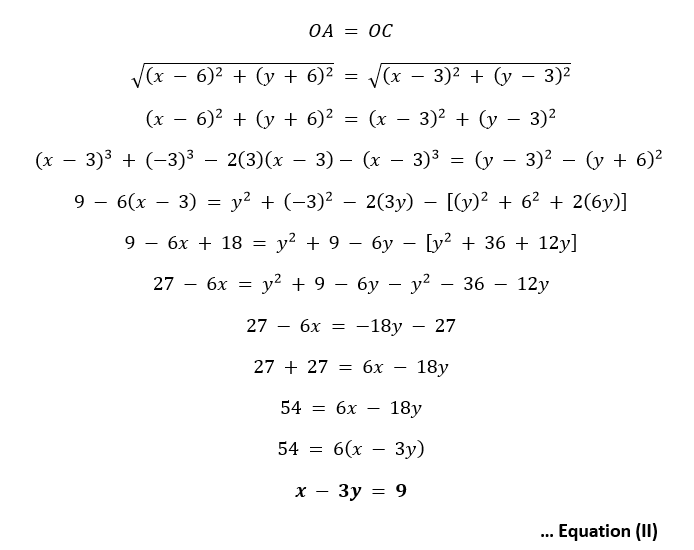
From Equation (II), we have: x - 3y = 9 x = 9 + 3y Substitute x = 9 + 3y in Equation (I), 3x + y = 7 3(9 + 3y) + y = 7 27 + 9y + y = 7 10y = -20 y = -2 x = 9 + 3y = 9 + 3(-2) = 9 - 6 x = 3 Hence, the centre of the circle lies at (3, -2). 4. The two opposite vertices of a square are (-1, 2) and (3, 2). Find the coordinates of the other two vertices. Solution Let the square be ABCD, with A (-1, 2) and C (3, 2). AB = BC as ABCD is a square. 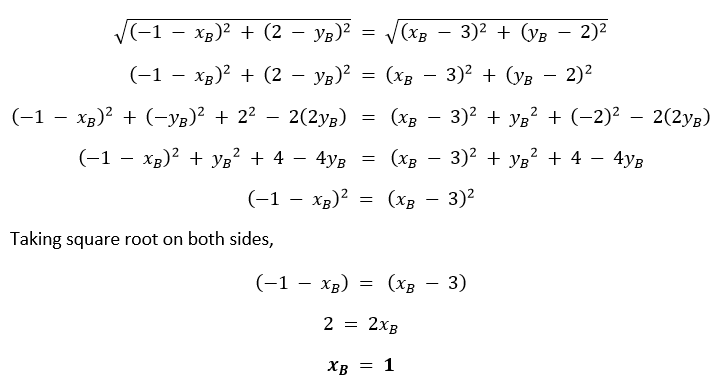
AD = DC as ABCD is a square. 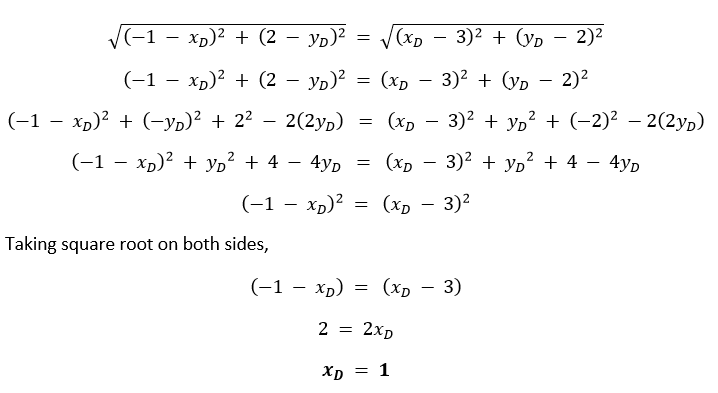
By applying Pythagoras theorem in ABC, we get AB2 + BC2 = AC2 (xB - (-1))2 + (yB - 2)2 + (3 - xB)2 + (2 - yB)2 = (3 - (-1))2 + (2 - 2)2 (xB + 1)2 + (yB - 2)2 + (3 - xB)2 + (2 - yB)2 = (3 + 1)2 + (0)2 (1 + 1)2 + (yB - 2)2 + (3 - 1)2 + (2 - yB)2 = (4)2 + 0 (2)2 + (yB - 2)2 + (2)2 + (2 - yB)2 = 16 4 + (yB - 2)2 + 4 + (2 - yB)2 = 16 (yB - 2)2 + (-(yB - 2))2 = 8 (yB - 2)2 + (yB - 2)2 = 8 2(yB - 2)2 = 8 (yB - 2)2 = 4 yB - 2 = �2 yB = 4 or yB = 0 Similarly, we can find that yD = 0 or 4. Since B and D have the same x coordinate, their y coordinates cannot be the same as that would mean the points B and D of the square coincide, which is impossible. Therefore, B and D are (1, 4) and (1, 0) respectively or B and D are (1, 0) and (1, 4) respectively. Hence, the other two vertices of the given square are (1, 4) and (1, 0). 5. The Class X students of a secondary school in Krishinagar have been allotted a rectangular plot of land for their gardening activity. Sapling of Gulmohar are planted on the boundary at a distance of 1m from each other. There is a triangular grassy lawn in the plot as shown in the Fig. 7.14. The students are to sow seeds of flowering plants on the remaining area of the plot.
Also calculate the areas of the triangles in these cases. What do you observe? 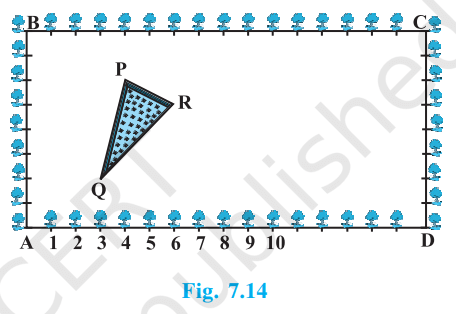
Solution I. It can be noted from the figure that P = (4, 6), Q = (3, 2) and R = (6, 5). Area of PQR with A as origin = ½[x1(y2 - y3) + x2(y3 - y1) + x3(y1 - y2)] = ½[4(2 - 5) + 3(5 - 6) + 6(6 - 2)] = ½[4(-3) + 3(-1) + 6(4)] = ½[-12 - 3 + 24] = ½[9] = 9/2 = 4.5 m2 II. It can be noted from the figure that P = (12, 2), Q = (13, 6) and R = (10, 3). Area of PQR with C as origin = ½[x1(y2 - y3) + x2(y3 - y1) + x3(y1 - y2)] = ½[12(6 - 3) + 13(3 - 2) + 10(2 - 6)] = ½[12(3) + 13(1) + 10(-4)] = ½[36 + 13 - 40] = ½[9] = 9/2 = 4.5 m2 Observation : Irrespective of the origin, the area of the triangle remains the same. 6. The vertices of a ∆ABC are A(4, 6), B(1, 5) and C(7, 2). A line is drawn to intersect sides AB and AC at D and E respectively, such that AD/AB = AE/AC = ¼. Calculate the area of the ∆ ADE and compare it with the area of ∆ABC. (Recall Theorem 6.2 and Theorem 6.6). [For reference : Theorem 6.6 : The ratio of the areas of two similar triangles is equal to the square of the ratio of their corresponding sides.] Solution D and E divide AB and AC is 1 : 3 ratio. Coordinates of D : 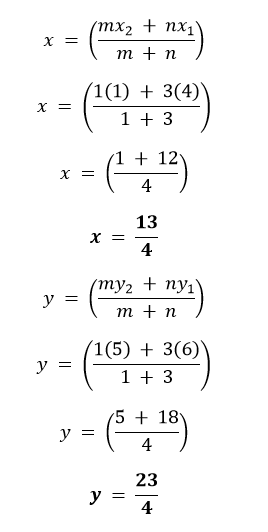
D is (13/4, 23/4). Coordinates of E : 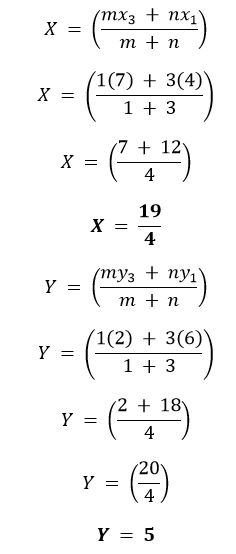
E is (19/4, 5). Area of triangle ADE = ½[x1(y2 - y3) + x2(y3 - y1) + x3(y1 - y2)] = ½[4(23/4 - 5) + 13/4(5 - 6) + 19/4(6 - 23/4)] = ½[4(23/4 - 20/4) + 13/4(-1) + 19/4(24/4 - 23/4)] = ½[4(3/4) - 13/4 + 19/4(1/4)] = ½[3 - 13/4 + 19/16] = ½[48/16 - 52/16 + 19/16] = ½[15/16] = 15/32 square units Area of triangle ABC = ½[4(5 - 2) + 1(2 - 6) + 7(6 - 5)] = ½[4(3) + 1(-4) + 7(1)] = ½[12 - 4 + 7] = ½[15] = 15/2 square units Ratio of the areas of the two triangles = Area of ADE/ Area of ABC = (15/32)?(15/2) = 1 : 16 Hence, ratio of the area of ADE to ABC is 1 : 16. 7. Let A (4, 2), B(6, 5) and C(1, 4) be the vertices of ∆ABC.
[Note : The point which is common to all the three medians is called the centroid and this point divides each median in the ratio 2 : 1.]Solution I. D will be the mid-point of BC as AD is a median. Therefore, coordinates of D are: 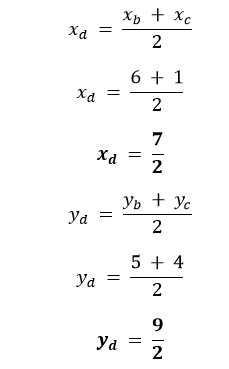
D is (7/2, 9/2). II. Coordinates of P are: 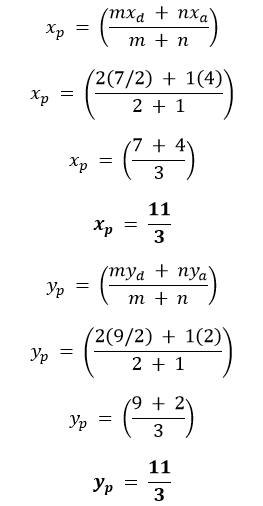
P is (11/3, 11/3). III. E will be the mid-point of AC as BE is a median. Therefore, coordinates of D are: 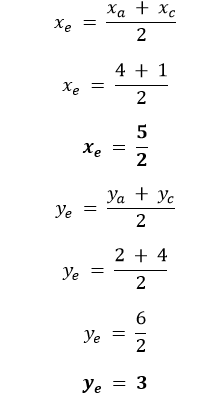
E is (5/2, 3). Now, coordinates of Q: 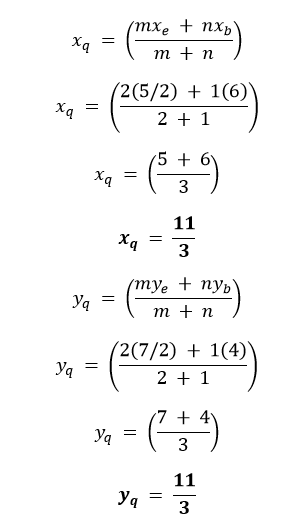
Q is (11/3, 11/3). Similarly, we can find that R is also (11/3, 11/3). IV. P, Q and R coincide as they are the intersection of all three medians called centroid of the triangle. V. For the given triangle, the coordinates of the centroid can be calculated as: 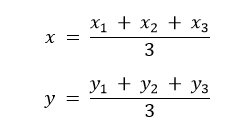
8. ABCD is a rectangle formed by the points A(-1, -1), B(- 1, 4), C(5, 4) and D(5, - 1). P, Q, R and S are the mid-points of AB, BC, CD and DA respectively. Is the quadrilateral PQRS a square? a rectangle? or a rhombus? Justify your answer. Solution Since, P is the mid-point of AB. Therefore, its coordinates are: 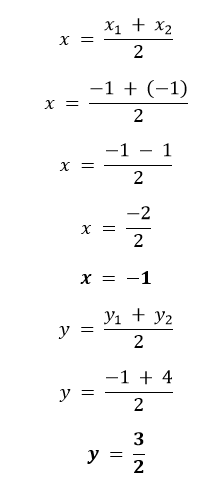
P is (-1, 3/2). Similarly, we can find that Q is (2, 4) R is (5, 3/2) and S is (2, -1). Distance between P and Q: 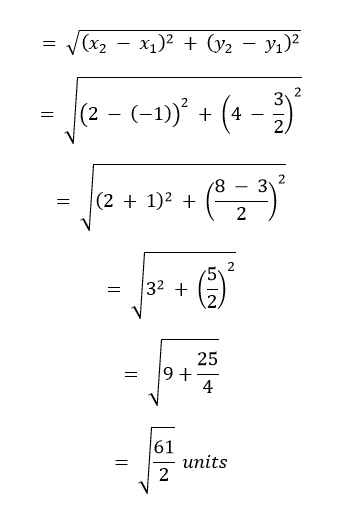
Similarly, we can find that 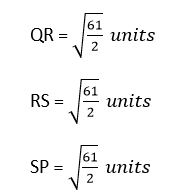
This implies that all sides are equal, therefore PQRS is either a rhombus or a square. 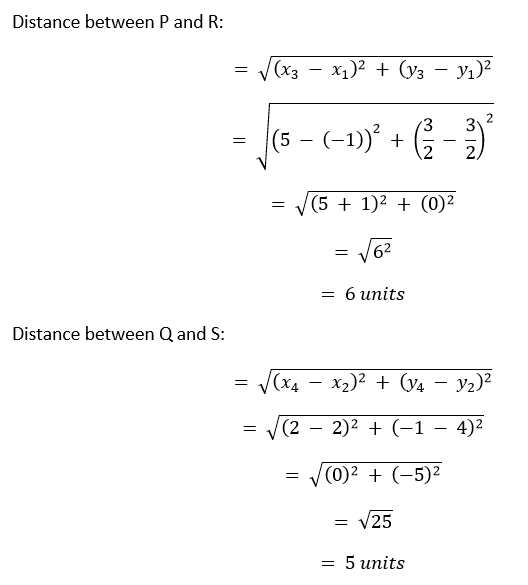
Therefore, we can conclude that PQRS is a quadrilateral with all sides equal and unequal diagonals. Hence, PQRS is a rhombus.
Next TopicClass 10 Maths Chapter 8
|
 For Videos Join Our Youtube Channel: Join Now
For Videos Join Our Youtube Channel: Join Now
Feedback
- Send your Feedback to [email protected]
Help Others, Please Share









